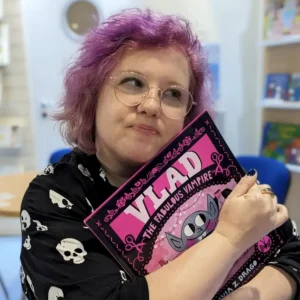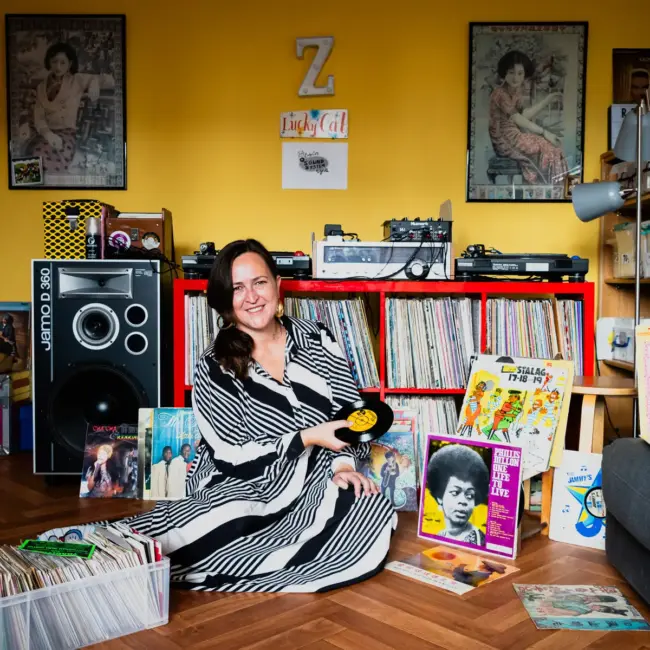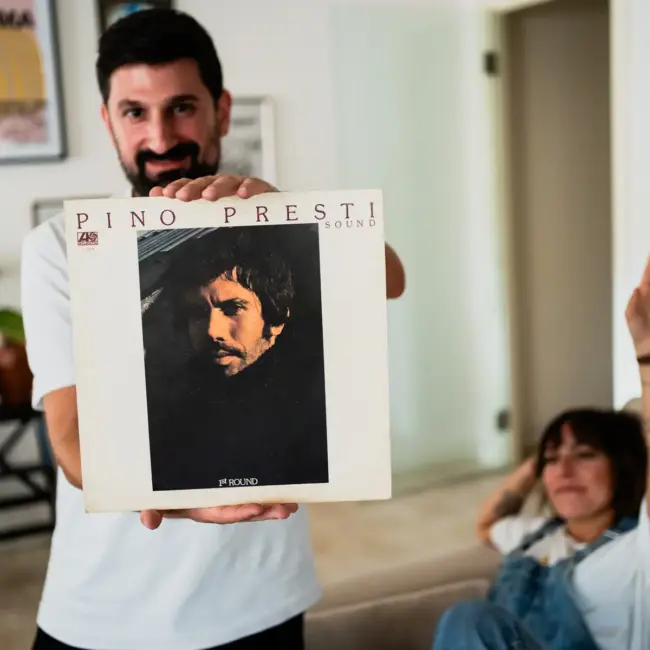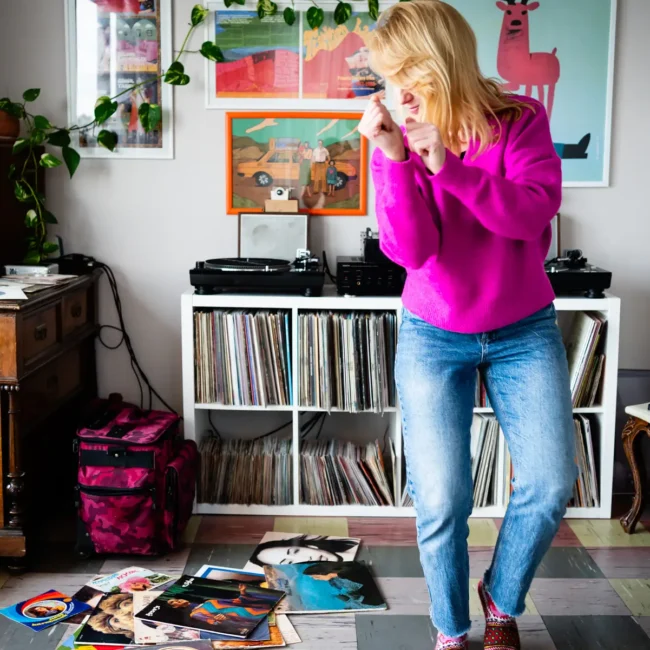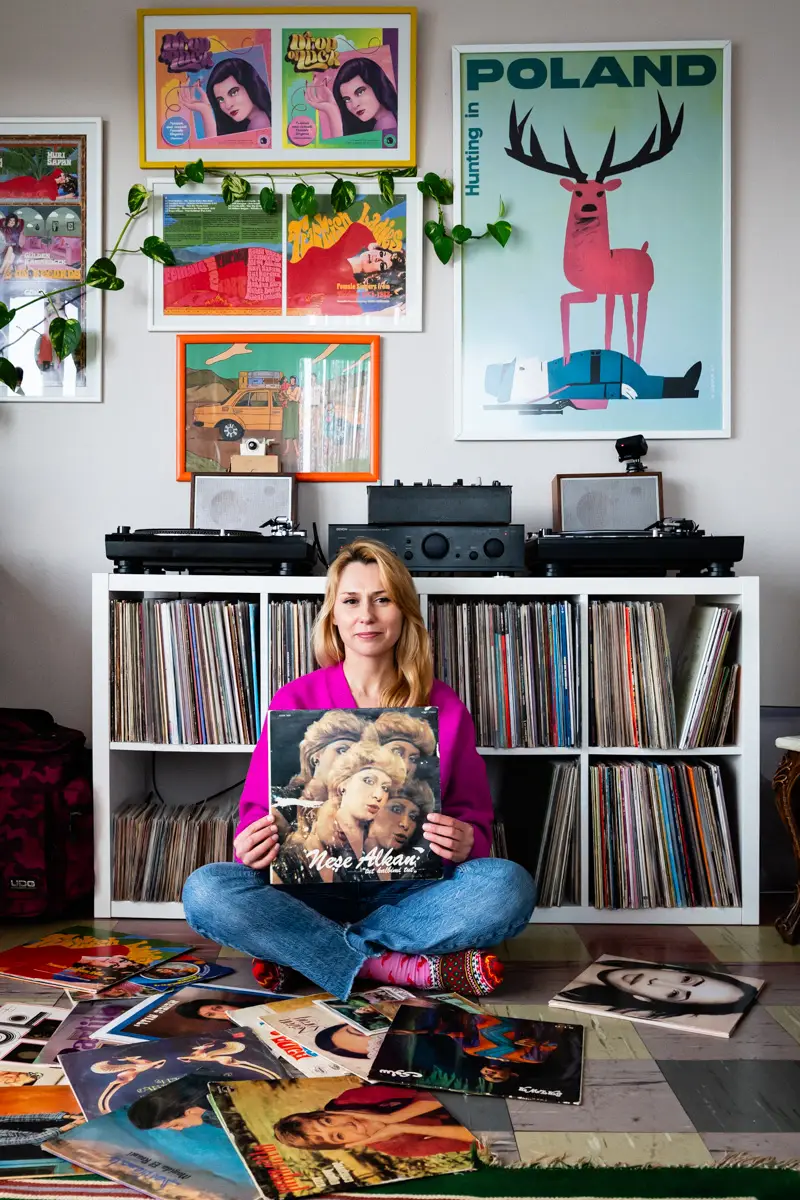
Kornelia Binicewicz
Ladies on Vinyl
BY Natalie Arnon
On an island near Istanbul, reachable only by ferry, lives a very special storyteller. She is a record collector, an anthropologist, a curator. What might read like the premise for a modern fairytale is, in fact, the story of Kornelia Binicewicz—the woman behind Ladies on Records. Through this project, her DJing, and her curated compilations, Kornelia tells us about the women both at the forefront and in the shadows of the male-led music industry. This is no ordinary record collector—this is a woman on a mission, and we’re here for it.
Kornelia’s Ladies on Records puts the spotlight on Middle Eastern female singers and musicians from the ’60s, ’70s, and ’80s. Using the power of colorful covers and irresistible grooves to draw listeners in, Ladies on Records teaches us what these albums truly represent. You might come for the artwork, but you stay for the history—the geopolitical and social realities behind the music. While her focus is often on Turkish and Middle Eastern singers, the juxtaposition of artists from different countries and backgrounds tells a universal story. Woven together, the experiences of immigrant Turkish women in Germany and the history of female Mizrahi singers in Israel remind us of the central role women play in music and culture—and why it’s so important to listen to their voices. In this way, Ladies on Records shows that music doesn’t only have the power to connect people but also to help them better understand themselves and the world around them.
Kornelia’s journeys are not solely audio-visual. Her projects take her across the globe, relying on a network of music lovers and fellow collectors to uncover new music and hidden stories. Her digging expeditions through record stores and private collections lead to deeper dives into everything her finds represent. As she says, each record is an invitation to jump into the rabbit hole. Forever a fan of the analog format, her curatorial work always begins with the physical object—a record, dusty and pre-loved, full of visual and cultural clues.
The interview with Kornelia began with questions about the whats and hows of her record collecting, but quickly turned into a conversation between two women about collecting, storytelling, and finding our place in the world. While music unifies and record collecting brings people together, there is still something distinct about the female experience. This is what Kornelia seeks to capture in her work and in her precise collection—and she does so in a way only a woman can. Ladies on Records is the culmination of her passion for music, digging, and research into the spaces women inhabit in culture and history. Do not be fooled—or rather, let yourself be—by the tunes she spins. This is no ordinary musical journey. It is an immersive educational experience, carried by a very funky retro beat.
“Most of the collectors I have met in my life are men. But there are more and more women, and we are collecting in a different way.”
—Kornelia Binicewicz
First of all, how did you start? Where did your passion for music originally come from?
For me, music is an element of culture, and one of the best ways to communicate with people. Music is like a window into somebody else’s life, history, social position, and personal experiences. I’ve always been interested in music as a tool to connect and to better understand the people around me, as well as those I’m curious about. It’s an invitation to explore more.
Of course, music is, first of all, music—an amazing sonic and emotional experience—but I also treat it intellectually. That’s connected to who I am; by profession and education I’m a cultural anthropologist, so music has been a way for me to understand the constructs of realities. Beyond its emotional element, music is also an intellectual entity that I love to explore.
Was it like that with music from your childhood? Do you go back to it now and look at it differently?
Breakout was my parents’ music for many years—the running joke in my family was that my mother should have married the lead singer, Tadeusz Nalepa. For a long time, this rock-blues band was simply my parents’ music. NOL is their non-blues album and not their most successful, but when I rediscovered it later on my own, I gave their music a new interpretation. Without my parents’ guidance, I had my own revelation about the band. I decoded them in a new way, through my own perspective, and suddenly saw them as a female-led band.
Krystyna Prońko, who was one of the biggest singers in Poland and who we all grew up listening to, and Partita, whom I discovered later, were female musicians at the forefront. Meanwhile, Breakout’s Mira Kubasińska is usually referred to as the singer’s wife. But for me, she is the band’s main attraction—she’s the leader.
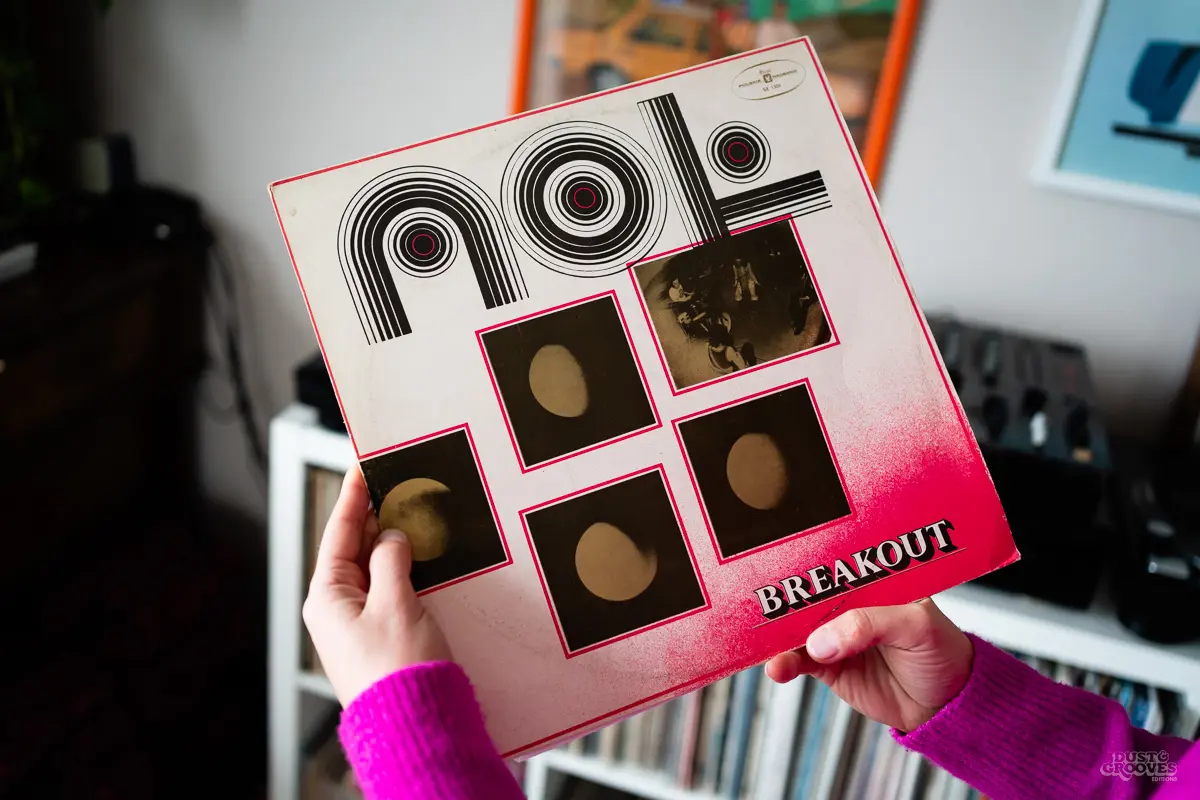
Breakout – NOL. “NOL is an acronym for Niezidentyfikowany Obiekt Latający—Unidentified Flying Object—a beautiful trip into Polish music spiced with folk and psychedelia. For decades, Breakout was labeled mainly Tadeusz Nalepa’s blues band. Mira Kubasińska, a female singer, was a member from the beginning, in 1968. It was my parents’ favorite group, so we had all their records at home. My mother was openly in love with the frontman, which was funny to family and friends. But Mira Kubasińska attracted my attention. For me, she was always the natural bandleader—boldly staring at me from the record covers—and her voice took me on the journey of their music.”
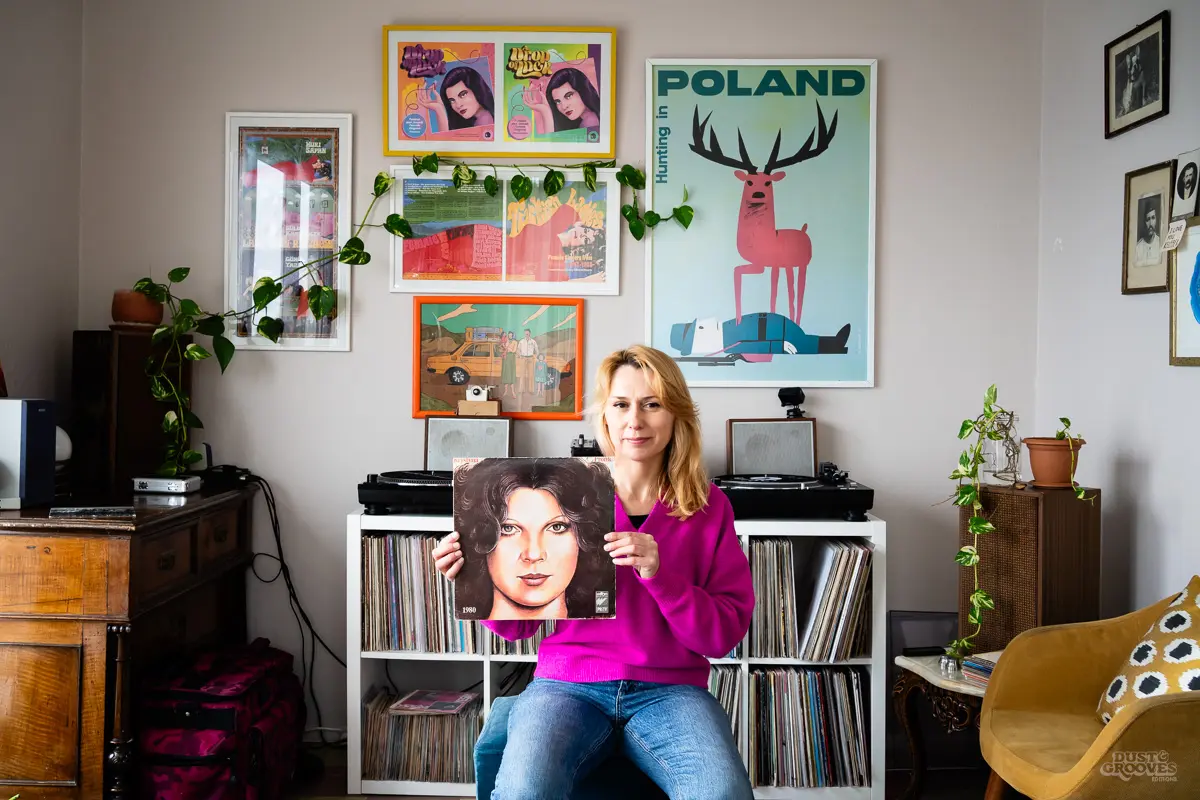
Krystyna Prońko – 1980. Krystyna Prońko is a Polish jazz vocalist and composer who started her musical career in the late ’60s. Despite her interest in avant-garde jazz and blues, she explored popular music styles, gaining nationwide recognition.
“I didn’t notice 1980 for years. The last two tracks on the B-side—‘Specjalne Okazje’ and ‘Oto Przyczyna’—mesmerized me, with orchestral groove, synthesizer magic, and sweet melodies sung by a mature and self-aware vocalist. The album proves that Polish music from the ’70s and ’80s has so many jewels.”
When collecting, are you looking for records that help you understand the culture better and explore it, to seek knowledge?
To continue reading this interview we humbly ask you to consider supporting Dust & Grooves by becoming a paying premium member.
Yeah, I think that for me, the craving, or the hunger, to understand better is always what’s behind collecting and finding music. I mostly, but not only, focus on the music created and performed by women from all around the world, and I’m trying to tell their stories through the music. I’m not only telling the stories of these singers but stories of women in general, and through this, I’m trying to tell the story of humanity. So, I think that’s the key in finding and buying records and in collecting—I’m trying to create a story that will somehow reveal something to me, that I would be able to share with others.
“If you have the record, you have this intimate time to explore, to dig deeper not only into the music but also into the story of the singer, the musicians, the label, the people who are listening to it.”
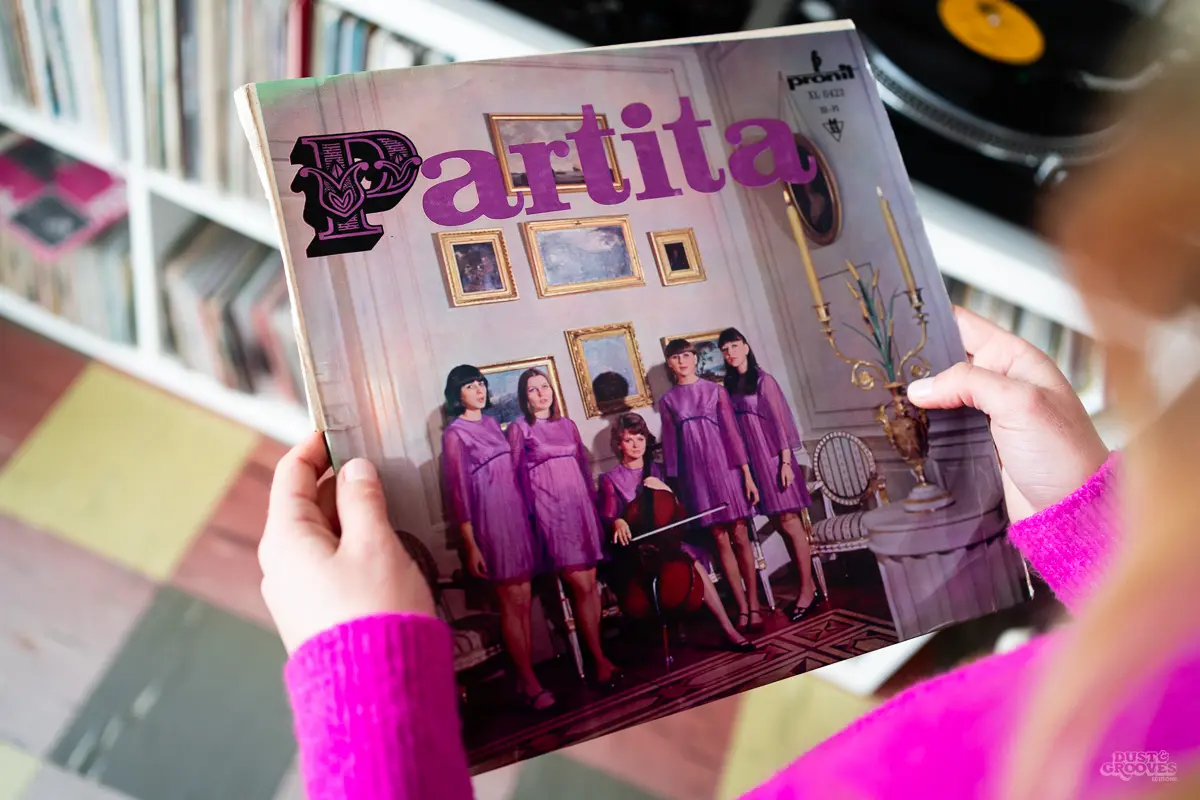
Partita – Self titled. Partita was the first Polish female vocal group created for Polskie Radio, the Polish national broadcaster. The band initially focused on classical repertoire, later developing a lighter and more popular style.
“I found the album at a flea market in Poland. It struck me first with its beautiful cover art. It was a lovely surprise to discover that Chopin, Beethoven, and Bach can be cool, groovy, and cinematographic in Partita’s arrangements.”
It’s interesting because as you said music has two levels, the emotional and the intellectual, and the records as a physical entity are like a cultural artifact. They have this double meaning for you.
Totally. Music is never created in a void. It’s a product of somebody’s dreams, and expectations—individual expectations and also societal or communal expectations. I love to discover how individuality is just in between these expectations. To see how the person is either blooming or becoming oppressed sometimes, in a situation that creates some kind of concept. Every genre is a frame, and the individual artist tries to find themselves in this frame. Through discovering a genre you can also understand all the political, historical, and social concepts that go with the music and the culture. There’s always a story behind music, and a record is the best tool to touch the story somehow. If you have the record, you have this intimate time to explore, to dig deeper not only into the music but also into the story of the singer, the musicians, the label, the people who are listening to it. You have it in your hands, and you are invited to jump into the rabbit hole!
How did you get into Lebanese music?
I was into the Middle East stuff and the belly dancing stuff and then I went into the ‘70s fusion of Middle Eastern jazzy sounds, and the Rahbani brothers. If you’re into Eastern sounds you have to visit Lebanese music, which was the mecca of the Middle East in the ‘60s and ‘70s. And then, you cannot avoid meeting singers such as Fairouz. It’s the most recognized and the most beautiful and accomplished music from Lebanon and the Arab World. Fairouz, even though she’s an extremely Lebanese singer, you cannot think of her only as that. She is so recognized and known in every country in the Middle East and the region connected to it.
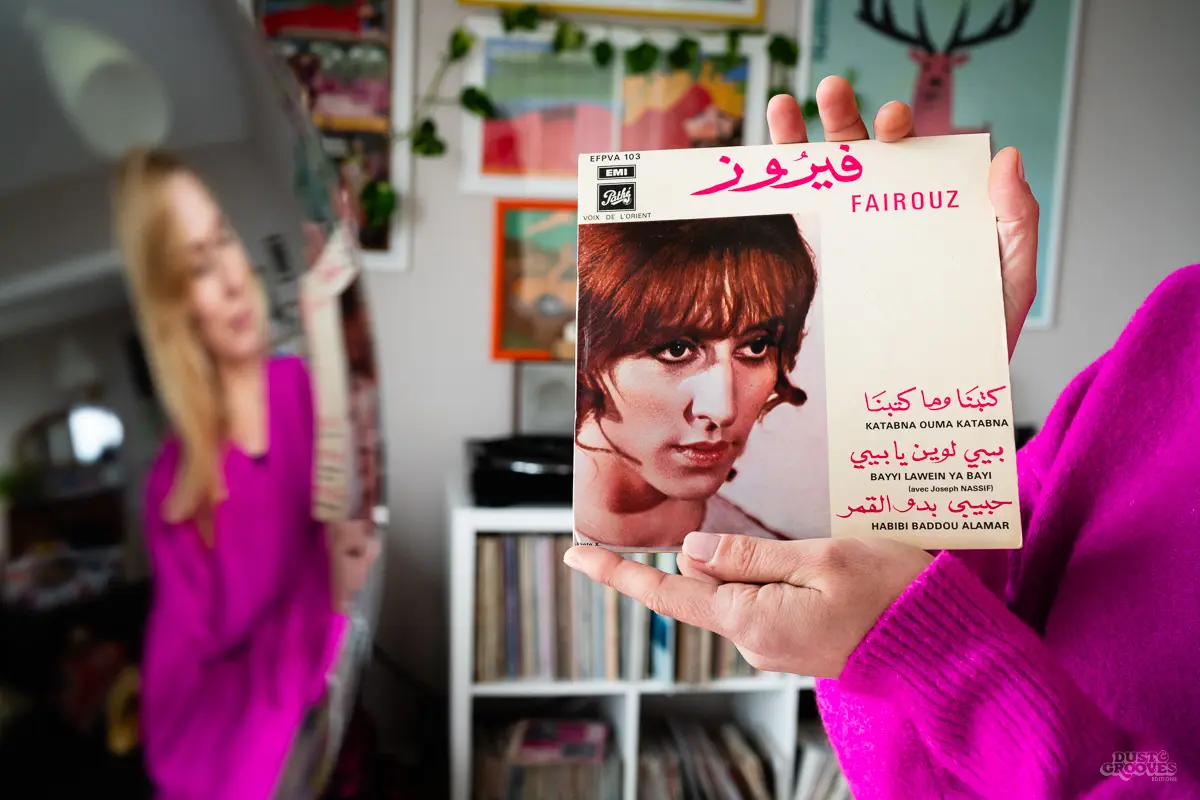
Fairouz – “Katabna Ouma Katabna”. Two singers united the Arabic world: Oum Kulthum and Fairouz. Fairouz, the Lebanese singer, is considered the most significant living female singer in the Middle East.
“Every Fairouz record is very precious to me. She has been a role model and a heroine for many artists and singers, both worldwide and here in Turkey. I got this single from a great collector and friend of mine, Albi, and it’s become one of my favorite Fairouz recordings.”
Can you talk about the place of arabesk music in your musical and cultural quests?
“I knew a lot of Lebanese and Mizrahi music before I arrived in Turkey. I was more into Middle Eastern sounds, and I understood that this element is very strong here as well. You can’t avoid arabesk if you come to Turkey—it’s one of the most popular styles, as beloved as it is hated. It’s incorporated into so much music, a combination of many styles and geographical influences. The basic element in Turkish music is the classic Türk Sanat, but that itself contains influences from Arabic music, especially Egypt and Lebanon, as well as elements from Western music—a true fusion of Turkish culture’s ingredients.”
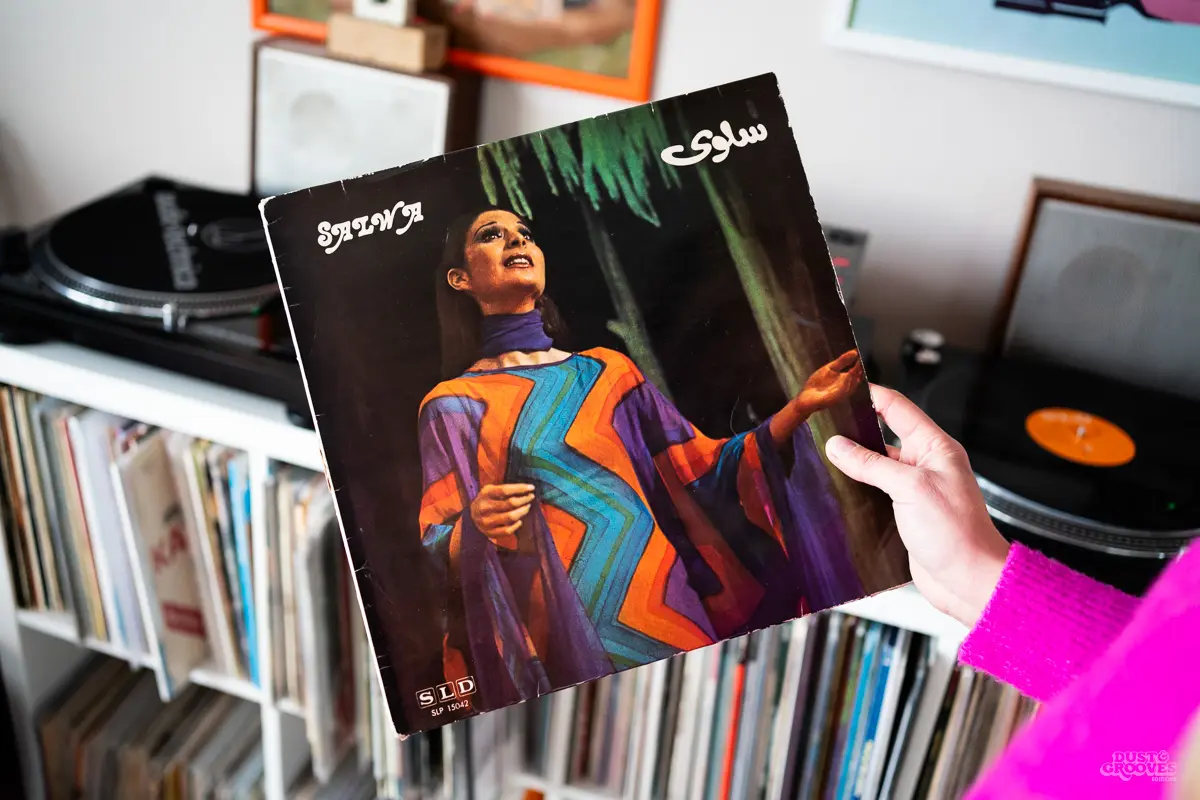
Salwa – Self-titled. “Salwa Al Katrib was primarily recognized for her acting career. She started her musical path in her early twenties and recorded until the 2000s. Salwa’s voice resembles Fairouz, the biggest diva of Lebanese music. I bought this record while visiting and digging in Tunisia in 2019. The record seller had kept it for me, hoping I would come back and appreciate the album. He looked at me and whispered, ‘I know this is your taste! Listen to Salwa!’ He was right! The album producers marked the best two tracks on the back cover with a pink star. Even though more than forty years have passed, those marked songs are still the best.”
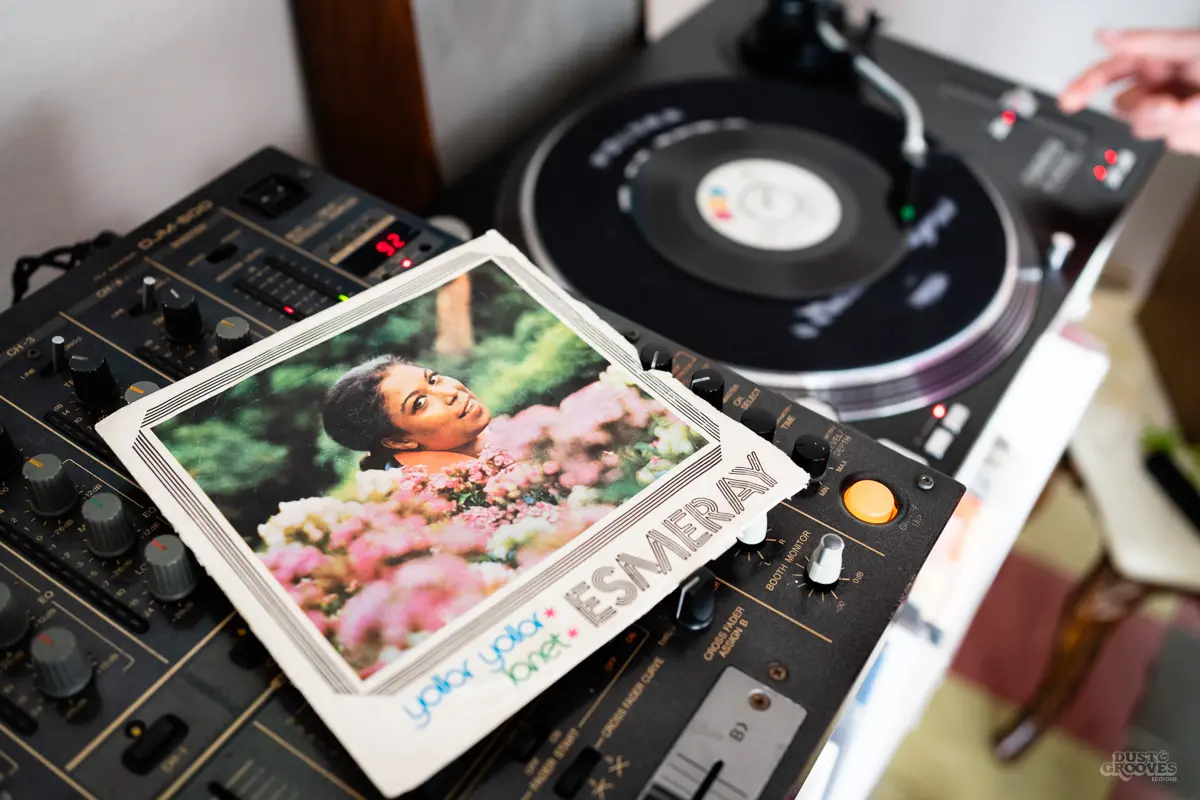
Esmeray – “Yollar Yollar / Lanet”. An excellent representation of Turkish psychedelic rock implemented into the sound of Arabesk and folk. Her musical style was unique; it’s impossible to compare her deep voice with any other Turkish musician. Esmeray is just one of a kind. Since the beginning of my journey into Turkish music, she has been my most loved artist because of her wonderful voice, but also her touching on unspoken issues of racism and prejudice towards Black people in Turkey.”
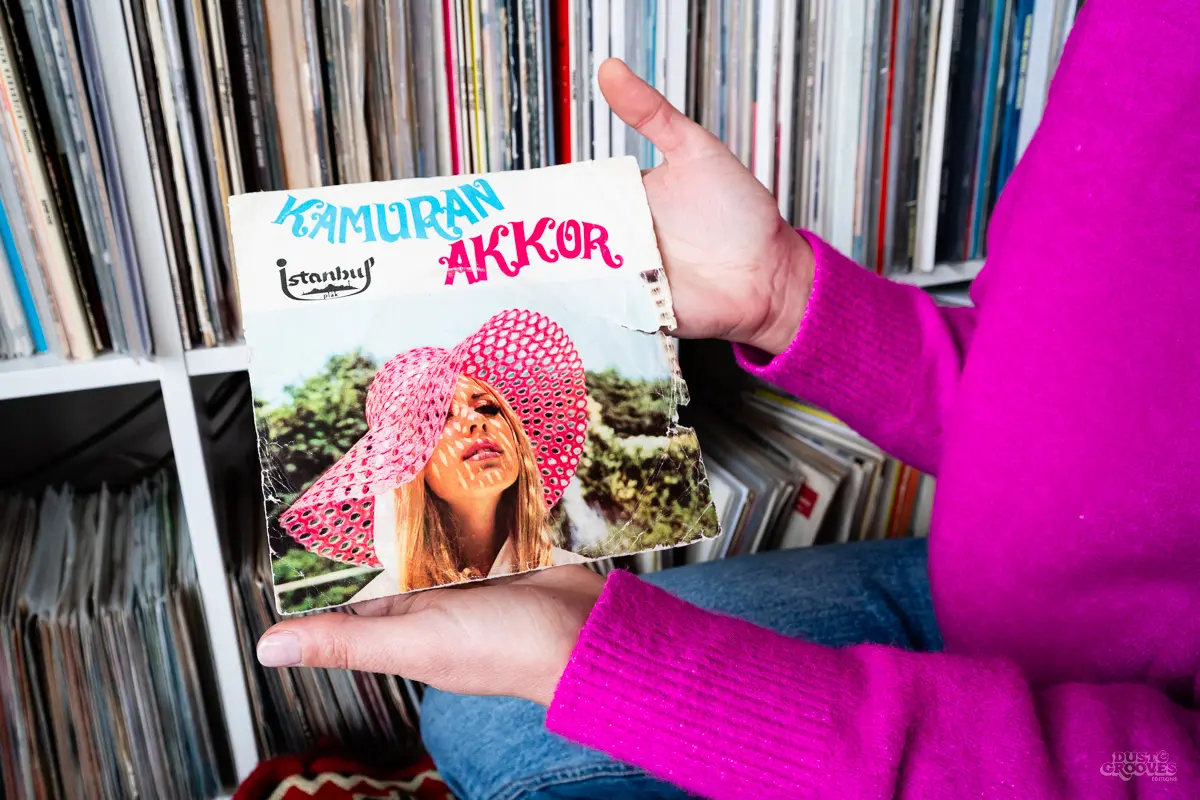
Kamuran Akkor – “Dilo Dilo Yaylalar / Falcı”. “Kamuran Akkor is a female Turkish singer who started her career in 1970 and worked with Turkey’s best arrangers and instrumentalists. She was widely known as an Arabesk performer, but her recordings from the 1970s have a strong psychedelic sound. I had the chance to meet her and learn about the inspirations and influences in her music. Her interpretations of Turkish folk songs were brave and progressive, expanding our understanding of psychedelic music from Anatolia.”
“You can’t avoid arabesk if you come to Turkey—it’s one of the most popular styles, as beloved as it is hated.”
How do you collect? Do you go by it methodically, do you just go to the record store and see whatever they have, or do you do both?
I think both; on one hand, I make an eclectic selection if I go and search for records, but on the other, what usually guides me is that I know I want to find records that were created and performed by women. This is the only light that never turns off in my head. But in terms of genres and aesthetics, I’m very open, so at the end of the day I come home with very eclectic music. For many years now, my research and work as a DJ, collector, and storyteller, has been focused on discovering and presenting the music created by women, so this is usually what I select. When I travel around the world or even when I go to the corner shop here in Istanbul, I first search for women in music. And then, I’m always also interested in music in general, so I come back with music that is possibly not related to women’s creativity in music.
I understand that women who have been involved in music, even if they were sometimes not so visible in the production of these records, were still somewhere in there. So somehow, I’m buying all the records that are created by men and women, and I don’t exclude men from my selections. But I have a focus and I want to understand the women’s stories because I think that their stories have not been told, the attention that was given to them was somehow not on whatever they were trying to tell us. Society was mostly focused on seeing them as kind of objects in the music industry, rather than creators. And very often we are not seeing them. I try to approach them in a new way, a humane way of trying to understand their lives, and their connections and positions, their interactions with society and politics. So this is what it comes down to in the end. Ladies on Records is about revealing some kind of story of women involved in music.
This makes the record not only what it is physically, but also something that encapsulates everything that it represents, everything that’s behind it.
Absolutely, nothing is what it is. The famous “This Is Not a Pipe”—it’s never a pipe! I’m not fetishizing records. I love them because they represent lots of things. I love them because they invite me into their universe. I love them because they are beautiful entities, a beautiful reality, but there is so much behind them. The fact is that I can hold them in my hands and it’s just the beginning of a story. I think that in vinyl you can have this very private moment of exploring music, something that has been lost. People consume digital music and they can’t connect the cover art with it, they don’t know who made the cover, who the band is, you know? It’s all disappearing. When you have a record you cannot omit any of this information, it’s just you and this. It’s a very analog and visible connection to the universe.
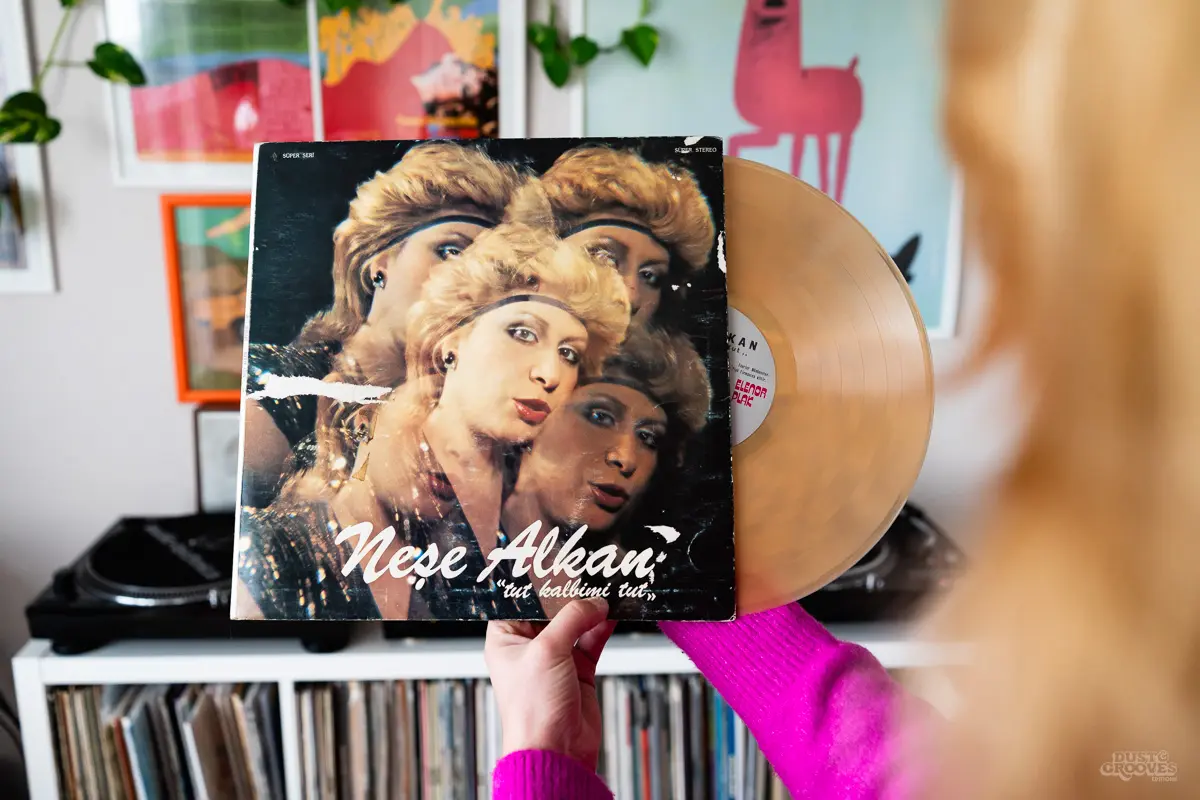
Neşe Alkan – Tut Kalbimi Tut. Neşe Alkan is a female Turkish singer who started her career in the 1970s, then disappeared from show business in the 1980s, just after Tut Kalbimi Tut.
“While I was working on Turkish Ladies, I came across Neşe’s album, with its beautiful disco-style cover art. At the time, I knew her folk-pop songs, such as Dilo Dilo Yaylalar and Kaçma Güzel from 1975.”
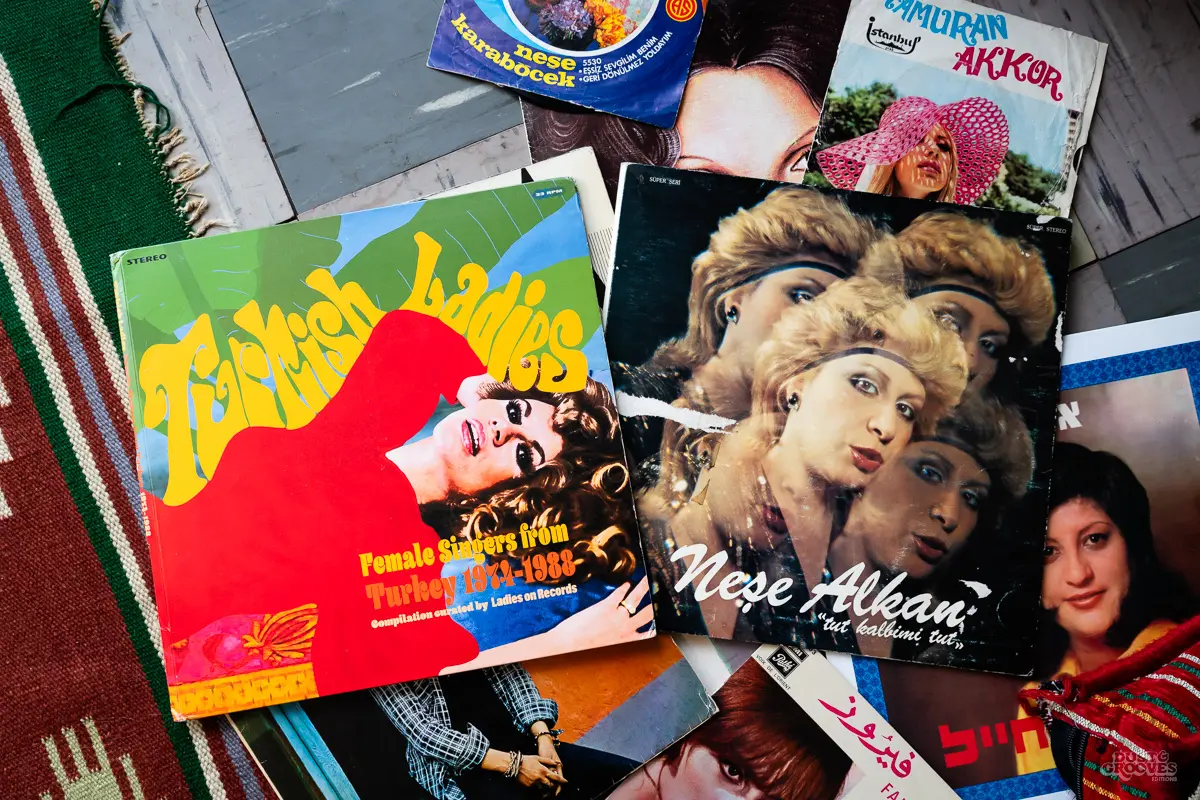
Turkish Ladies – Female Singers from Turkey 1974–1988. “This compilation was released on Sony Music Turkey but contained music owned by three Turkish labels: Elenor, Türkuola, and Şah Plak—each specializing in different music and styles. The creative process of the compilation was a beautiful journey. I was happily digging in the labels’ archives, meeting artists, and exploring their stories. Studying the labels’ catalogs allowed me to show a broad spectrum of Turkish music performed and created by women in the ’70s and ’80s. The cover girl of the album is Huri Sapan; her stories helped me understand the complexities of being a woman in the Turkish music business.”
You use your collecting and curating to tell a story, can you talk about how your Turkish Ladies compilation happened? Was it an easy pitch?
After I made a psychedelic mix album, I actually thought I’d go another way, maybe somewhere else. But then Sony Turkey reached out and suggested I look through their catalogs and do something. I knew exactly what I wanted to do—to reflect on the music of Turkish women. I always wanted to make a compilation like this. They were very happy with the suggestion and appreciated the perspective, there’s no other compilation out there that is dedicated to Turkish women. Sony gladly opened their back catalogs and the catalogs of the labels they represented and let me dig. It took a year for the album to be completed, but in the end it was out and I was happy I could give something to Turkish cultural reality.
Further Adventures in Record Collecting
Dust & Grooves Vol. 2
Kornelia and 150 other great collectors are featured in the book Dust & Grooves Vol 2: Further Adventures in Record Collecting.
Does your curating and storytelling also come across when you DJ?
Absolutely. I mean, in DJing it’s not that easy to tell a story. On the dance floor, there’s only one objective: you have to make people dance! So sometimes telling the story is not that important. However, I’m still trying to do that even in my DJ sets and somehow still tell the story. I’m not a Collector, you know, in the sense that I don’t have a wall of records. But the records that I own, the records that I collect and buy, they are voices in a story. They are a part of my story-building. I think that with my records, I curate a story.
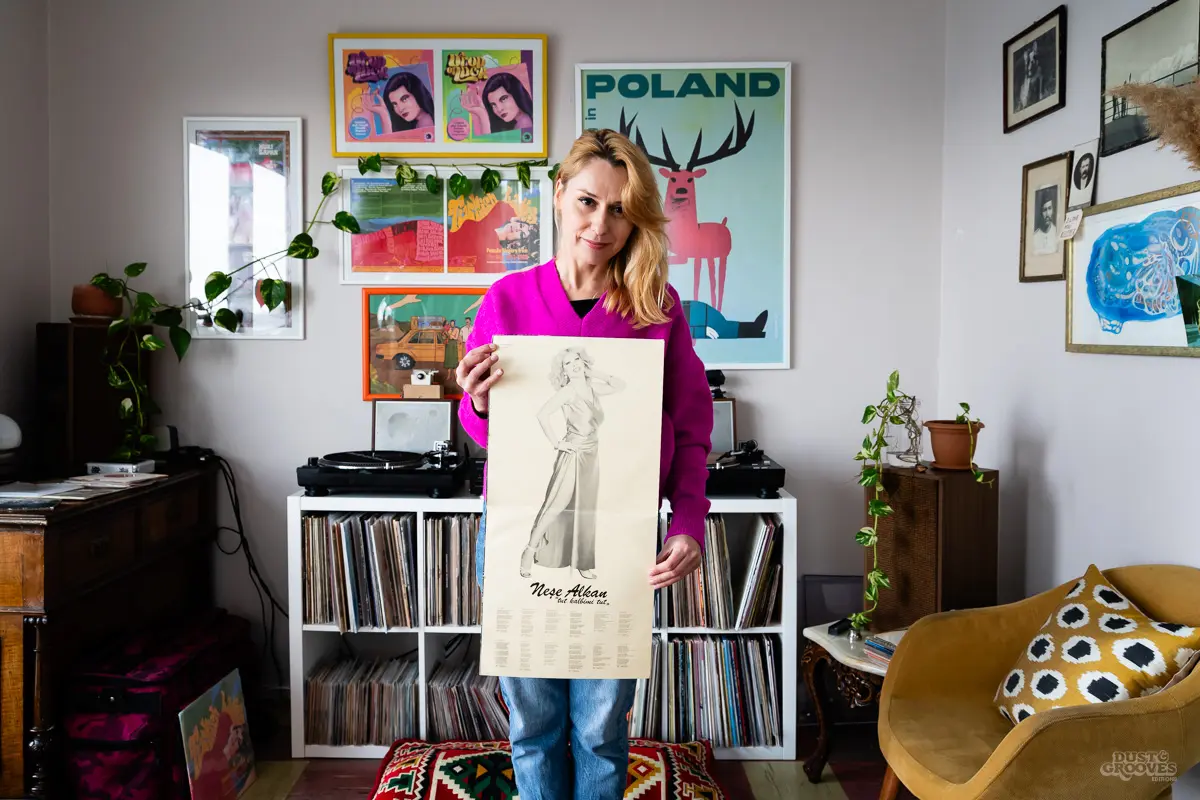
Neşe Alkan – Tut Kalbimi Tut. “Neşe Alkan brought the album ready to her label, Elenor, and took absolute control over the production process, insisting it be released on colored vinyl. The amber vinyl matches beautifully with the cover art. According to Elenor’s owner, it was the first colored vinyl pressed in Turkey. Neşe was known for her brave stage costumes and her positive attitude toward her own body. She was proud, charming, and mesmerizing, despite the harmful expectations for female artists to be slimmer.”
Do you find that people, mostly other record collectors, look at you differently because you’re a woman in this field?
Well, no… I mean, for a long time the women who were collecting records were invisible, and now we have much more space to exist. This is due to the fact that we can communicate more easily. I think it’s an anachronistic old-fashioned belief that there is an issue. The older I am, the more I think that gender is really just a construct, we’re finally getting out of what we define as male or female.
“Most of the collectors I have met in my life are men. But there are more and more women, and we are collecting in a different way.”
I was recently thinking how in twenty years we will be an absolutely different society, most probably, and my Ladies on Records will be so anachronistic and so old-fashioned that everybody would say it’s not politically correct. And I thought ok, it would be like a museum object that shows how we, women, were forced at some point to state our gender identity. In fifty years maybe this gender-fluid reality will be so positively overwhelming that we will not have to state it anymore. But we’re still not there, we still have to say, OK, I am a woman, and I have not been able to do many things and now I want to talk. Now it’s time to tell the story that hasn’t been told.
Most of the collectors I have met in my life are men. But there are more and more women, and we are collecting in a different way, which is really interesting. Very often I think that I might also be kind of a representative of this sort of feminine collecting. I think women collect more with purpose, rather than the fact of fetishizing the vinyl. Men are very eager to fetishize the concept of collecting, while women very often have an agenda, a program, behind it. We do something to say something. I think that’s the difference, and there’s no competition between male and female collectors. The men are collecting just for collecting, and women are collecting to tell a story. I think this is a very complementary situation, having both ways of exploring and collecting. I never had any bad experiences with male collectors, on the contrary. I think they’re very happy to be finally dealing with women, and with that, there’s a different approach, different way of communication, different choices.
I think, as you said, it’s opening up and there are more women in this field, and I think there’s some kind of fetishization of women collectors as well. Like record stores or books about vinyl will always have a pretty girl looking through records.
Ah, that’s true. But I think it will pass. It still happens a lot, and we also have women falling into this trap and acting according to the expectations. That’s ok, I believe in pluralism in polyphonic surroundings. But I know that lots of men are eroticizing collectors, right? This should change because it’s incorrect, but I think that women should also help in this process, stop being objectified. But it’s a trap, we all live in the reality where the main concept is beauty so it’s very confusing how to act, who shall we be. Sometimes I don’t know who I should be, more beautiful or more clever. What is more desired?
And it’s like this catch-22 where you feel you can’t have both.
Because I deal with women’s music, I feel that I don’t have to be that beautiful anymore. They’ve done their job, you know? They were so objectified. And I play with it because I show the covers, I show how they acted, but then I dive in and I tell the story of their lives or how they worked on this album and what they came across. And you cannot look at them anymore as the cover girl. You have to look at this woman as a human. You have to look at her and her life story, and the universal story of other women too.
I have male friends who are collectors, and I don’t see a lot of women in my social circles who call themselves collectors. Maybe it’s changing with the younger generation, but I do agree, and I also read this in some places, that women find it easier to identify as collectors if they have a focus if they curate a certain style. Men are less so.
I do believe it’s like that. Women are always on a mission, you know? “What shall we do? How can we improve the situation?” It can be records, it can be whatever. So very often we have an agenda. Men very often follow competitiveness, they are more focused on building something for the sake of building. Us, I think it’s more about our expectations. I mean, now we are generalizing because I also know women who are into really huge collections and they just collect because they like something particular, and it’s only musical. But I think we get encouraged into collecting because we understand that in the music there is also something else. That it’s not only about the object.
Who are the Turkish female singers most featured in your collection?
Ah, so many! Selda, Kamuran Akkor, Esmeray, Tülay Özer, Hümeyra, Ajda Pekkan and her sister Samiramis, Neşe Karaböcek and her sister, I have most of their stuff.
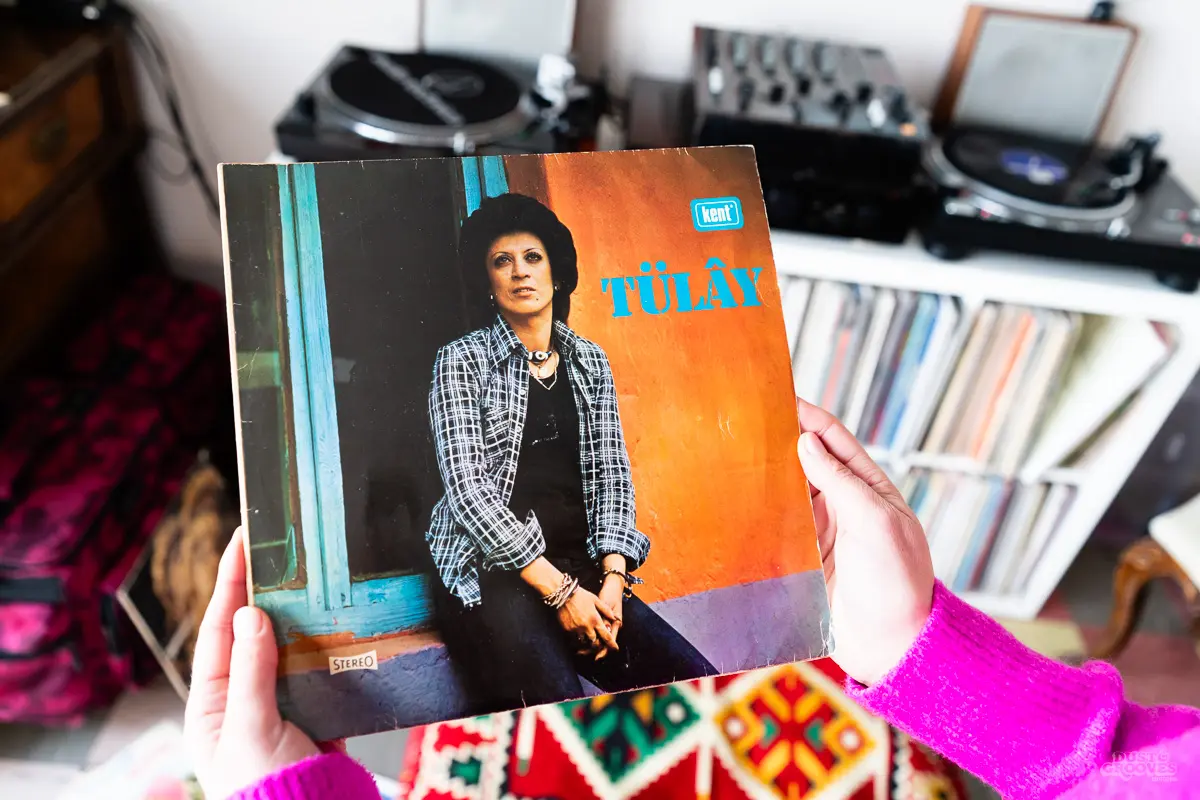
Tülay Özer – Tülay. “Tülay is the sister of famous pop singer Zerrin Özer, and one of the hidden treasures of Turkish psychedelic folk-rock. She recorded a few albums and singles with Esin Engin, the most forward-thinking musician and arranger of 1970s Turkey. Released as a 10-inch in 1977, it remains one of the most precious jewels in my collection of Turkish music. All of Tülay’s ‘70s singles on the Kent label are great.”
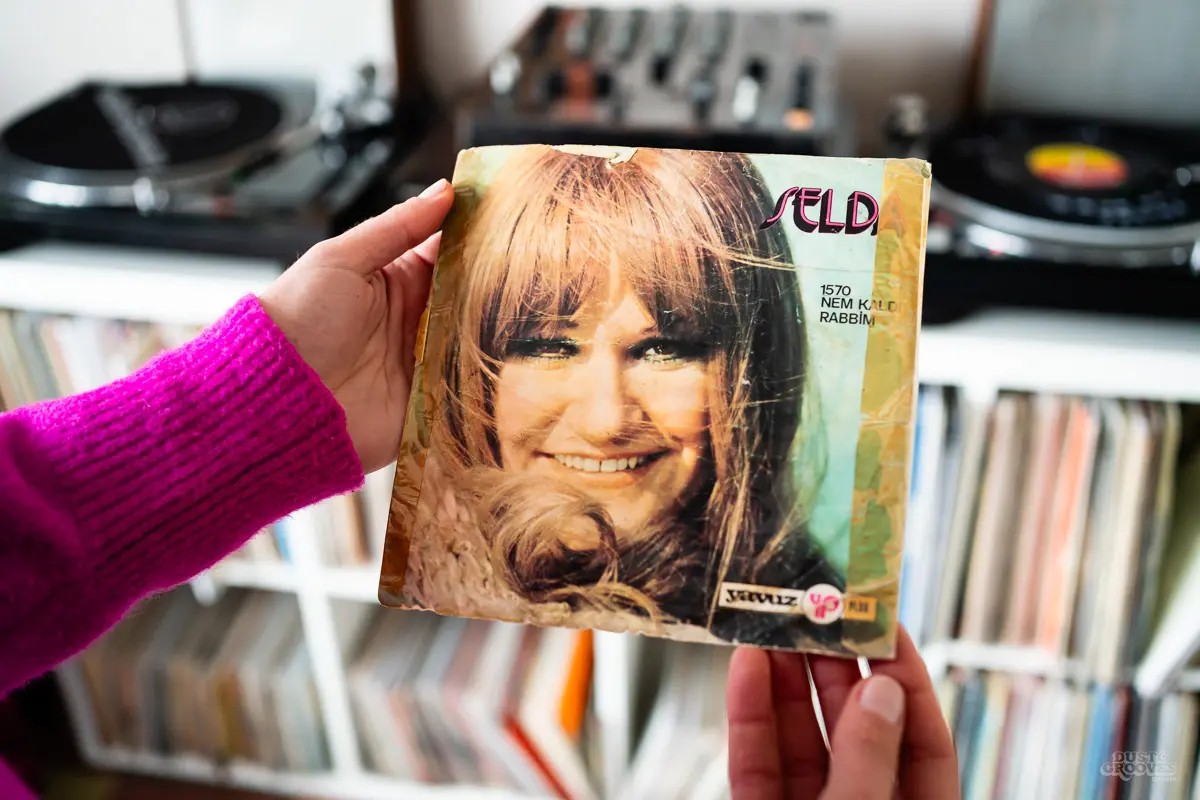
Selda – “Nem Kaldı / Rabbim Ne İdim Ne Oldu”. “Selda Bağcan is the most recognized Turkish female artist of the Anatolian rock genre. She collaborated with the most progressive bands and musicians of Turkish music in the ‘70s. Her musical style is deeply rooted in Turkish folk and the tradition of aşık music. She has always stuck to her Leftist beliefs, singing about social injustices and oppression. Nem Kaldı / Rabbim Ne İdim Ne Oldum was recorded with Kardeşler in 1976 and is undoubtedly the best example of Selda’s style. Every album and single of hers has a special place in my collection.”
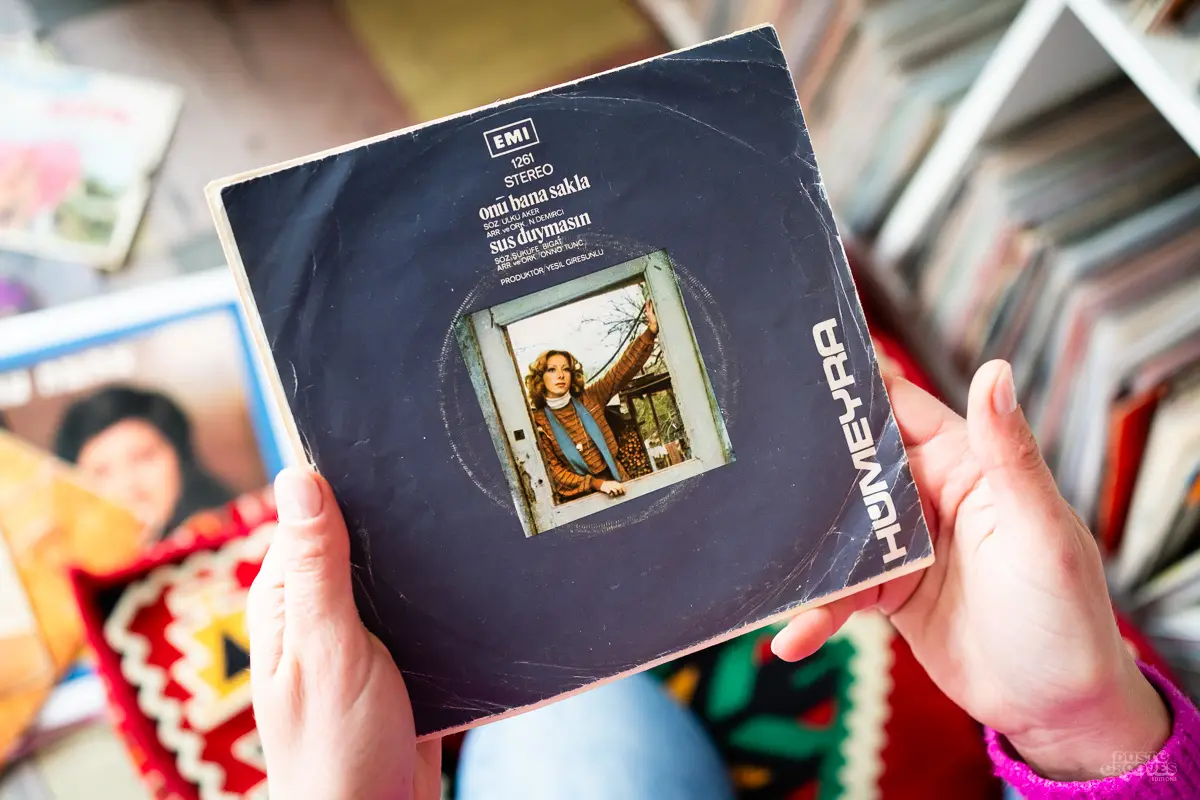
Hümeyra – “Onu Bana Sakla / Sus Duyması”. “One of my favorite Hümeyra singles. While the B-side, Sus Duymasın, is a beautiful ballad in the typical Hümeyra style, the A-side delivers a fantastic disco-ish halay (a folk tune from southeastern Turkey).”
Ajda Pekkan encapsulated the history of Turkish music in the twentieth and twenty-first centuries. Her career is like the encyclopedia of Turkish popular music. She worked with female lyricists and was always at the center of what was current. She’s now almost eighty years old and looks younger than me, she still performs.
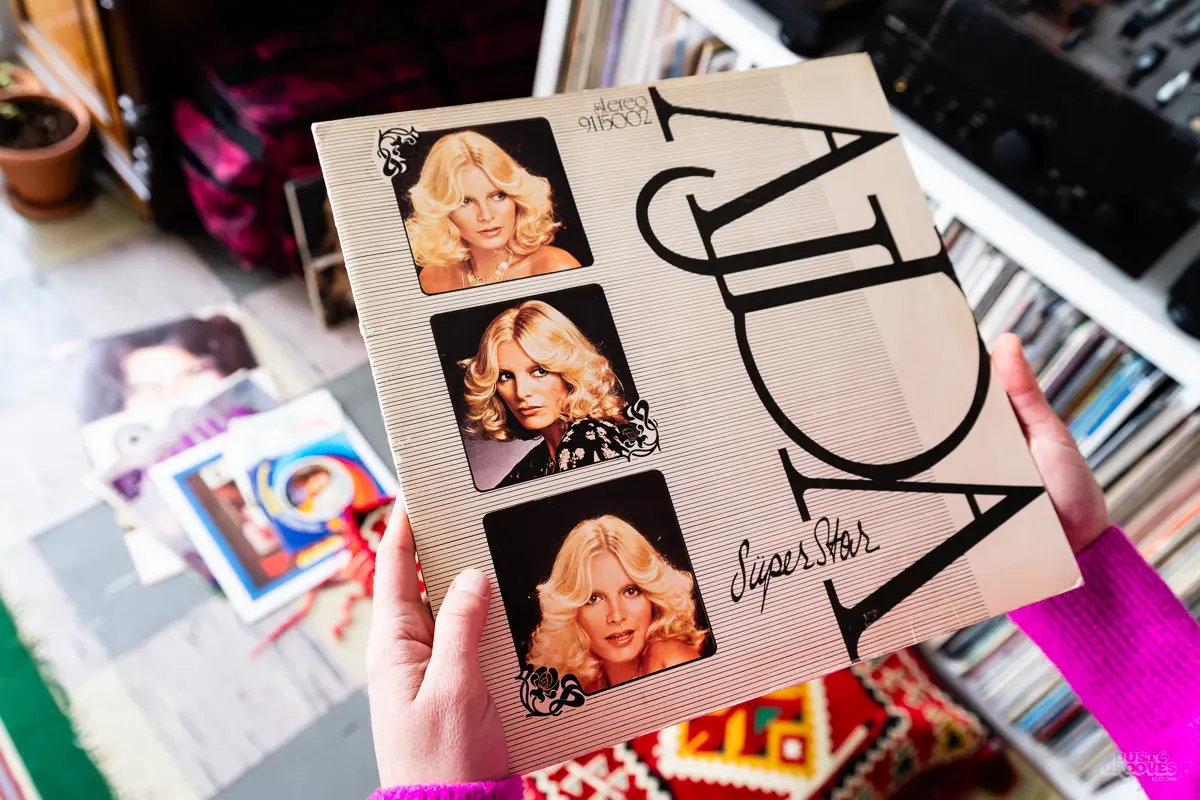
Ajda Pekkan – Süper Star. “Ajda Pekkan was a natural-born star. Her music career is essentially the history of Turkish popular music. She always followed the hip styles and was very successful in the early years of her journey. My favorite track, ‘Baksana Talihe’, is Ajda’s cover of Kai Warner Oriental Express’s ‘Fly Butterfly,’ also known as ‘Kavir-E-Dell’ by Iranian singer Marjan. Ajda first recorded the song in French as ‘Viens Dans Ma Vie.’”
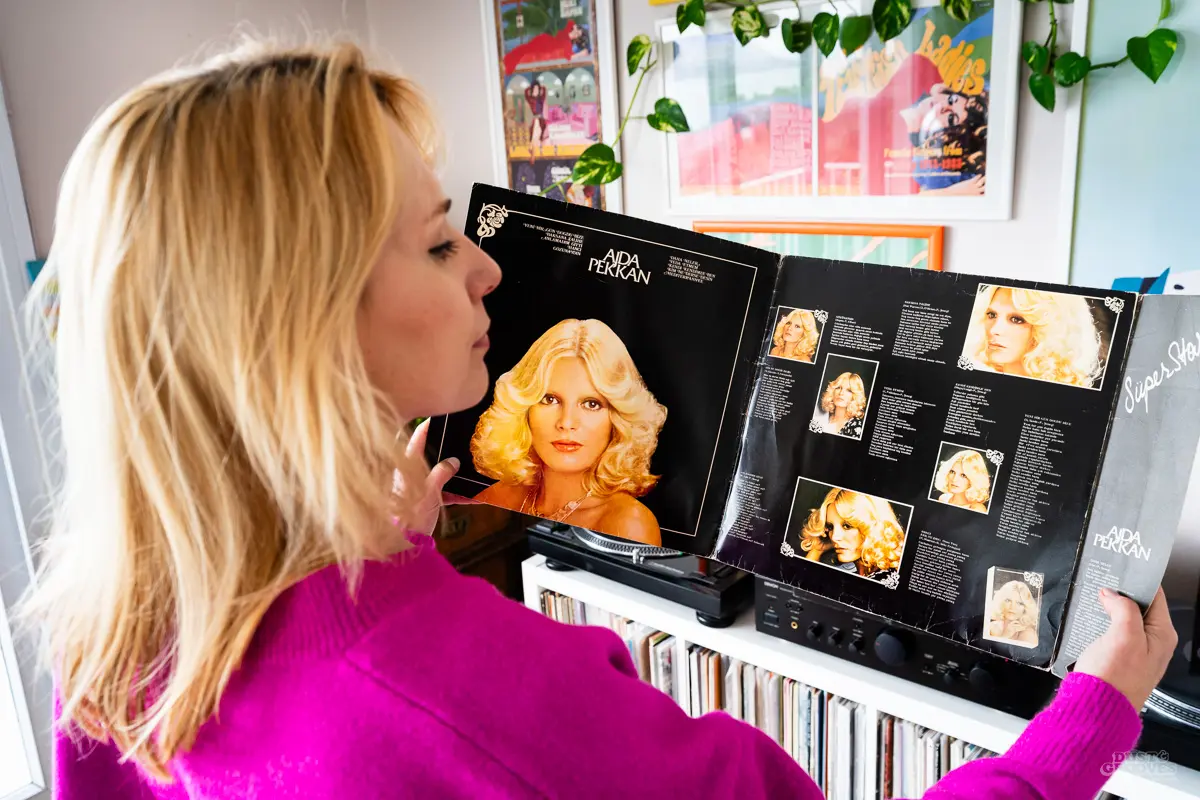
Ajda Pekkan – Süper Star gatefold.
Turkish singers being also actresses was a common concept in the ‘70s and ‘80s when cinema and music were interconnected. People would go out to see a movie, and the female character would do a song, and the next day they all wanted to buy it. So the record companies pressed many copies of these singles, and they were a hit. From that starting point, they also had their own careers in music.
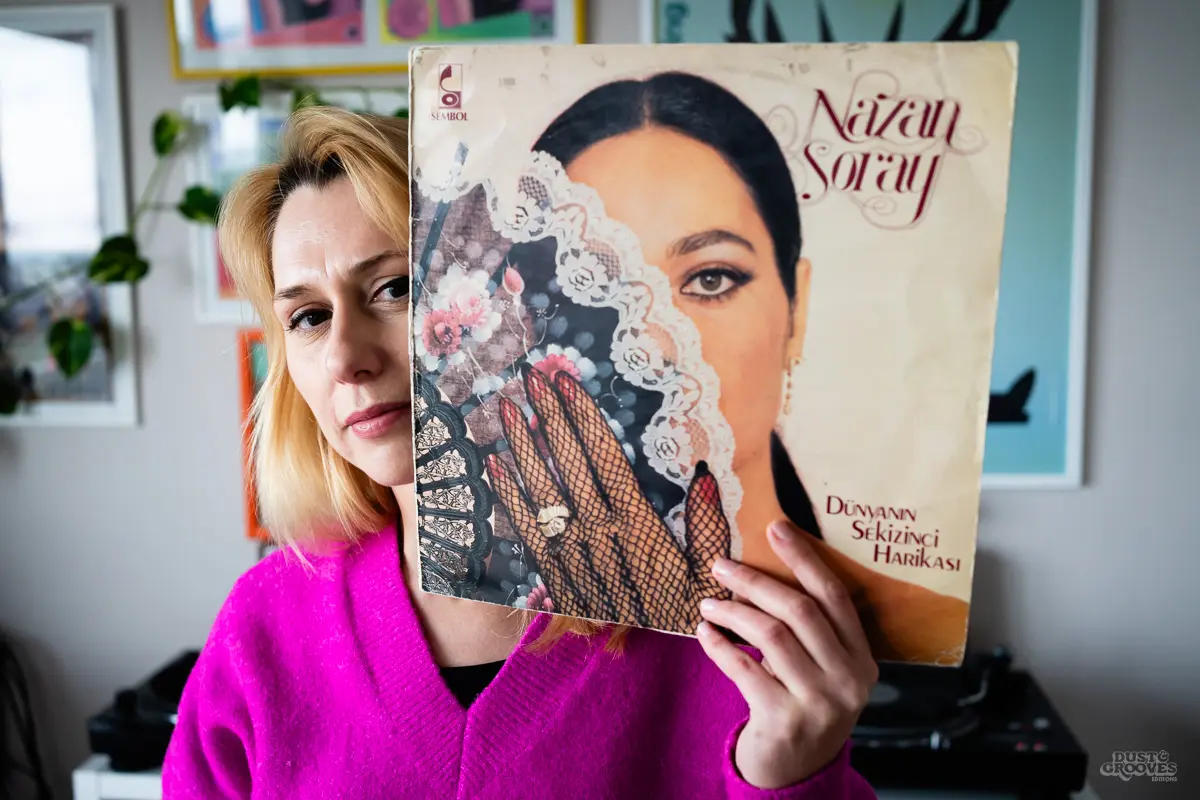
Nazan Şoray – Dünyanın Sekizinci Harikası. “Nazan Şoray was the younger sister of Turkey’s most famous actress, Türkan Şoray, and like her, she began her career as an actress. In the ‘80s, Nazan focused on music and gained popularity with a cover of Barış Manço’s ‘Hal Hal.’ Dünyanın Sekizinci Harikası was her second LP. I love Nazan’s voice—it’s sweet and very melodic. Her interpretations of Turkish folk songs are distinctly feminine. Excellent arrangements, early-1980s Moog, and synthesizers place this album between easy-pop and psychedelic Anatolian music. My favorite track is ‘Hatuney.’”
Where do you get your music from? Do you buy online, or do you go crate-digging? When you travel, how do you know which record stores and collectors to approach?
I buy records only from record stores and places where I can find records in the physical way. I never buy online, or I can count on two hands the records that I bought online. I always go and buy, and for that, I need to travel; I need to go to the record store, sometimes to collectors’ houses for exchanges. This is my way. I don’t do Discogs at all.
I’ve lived in Istanbul for six years, and when I arrived I immersed myself in digging. For one month I was only digging, and just talking to people—who has what? And then somebody told me “Ah, that guy has a collection at home, go there” and so on, so that’s how I did it. When I was in Columbia I did exactly the same thing, I knew one person, and then that person knew another. There were actually no record stores in those days, or I couldn’t find the ones that I was really interested in. I was mostly into cumbia and chicha, so I just talked to people and took cabs to some weird neighborhoods and into people’s houses, with their children and wives and everything! I enter the house and the guy puts all his records on his bed and says “these are for exchange”, and you are diving, you are touching. I’m not buying the records online, I have to see them, to listen to them. Because for me it’s a personal history, I buy only in the normal way as our grandparents did.
Do you keep in touch with all these sellers and collectors you were dealing with? Are you also interested in the stories of how they came to have these albums?
Yes, we leave a trace on the record so the story of someone who owns it is always very interesting. We also talk about this stuff. How did you come to have it, what does it mean to you, why are you exchanging it, why don’t you want it? It’s very interesting how people are getting rid of some records at some point, or how their aesthetics have changed and what they do with these records. For me, I very seldom exchange my records now, I feel very connected to them. I keep them, but if I have double copies, or I buy one and then get another copy, usually that’s what I exchange. Other than that, every record that I have is exactly the record that I want.
That’s a very hard thing to achieve.
It doesn’t mean that I have all the records that I want.
But everything you have is there for a reason.
If it’s there that means it’s important. Or it was, and maybe it will be important again. They are my treasures, I really connect to their stories and I always come back to them. For example, my biggest collection is of Turkish music, and the records I bought like six or seven years ago, now they are not so important to me anymore. But after I while I find them extremely interesting, for instance, the B-side of a single is a total killer and I would kill myself if this killer was not with me because then I couldn’t tell the story I am about to tell right now.
“A wish list is very good for Discogs. But if you go digging, you’re coming back with a record that you never heard of.”
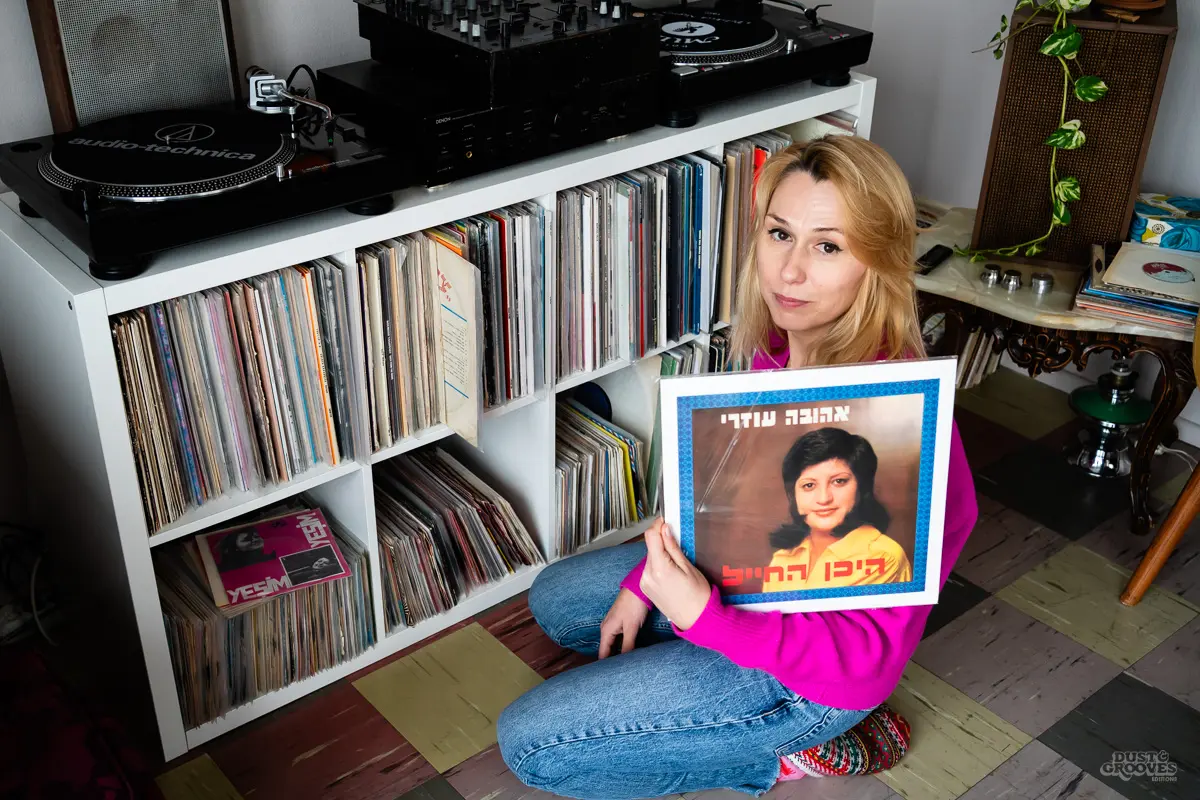
Ahuva Ozeri – Heichan Hachayal. “Ahuva Ozeri, an artist of Yemenite origin, was the sound of multicultural Tel Aviv. She was a pioneer of ‘world music’ long before critics coined the term. She was also a voice of the Mizrahi community that settled in Kerem HaTeimanim. Ozeri was a master of the bulbul tarang (an Indian instrument) and a spectacular singer. This 1975 release introduced a vivid and polyphonic culture of Yemenite origins into Israeli mainstream music. Tel Aviv diggers Ofer Tal and Uri Wertheim introduced me to the album. Since then, Heichan Hachayal has been one of my favorite and most-listened-to albums.”
Do record collectors, who know what you might want, reach out to you and say, “Look, I have this collection that maybe you should check out?”
People usually know that I live here and I very eagerly help them find records in Istanbul, so whenever anyone I know, even online, comes to Istanbul—I always come and help them dig. This is my contribution to their collection. I ask them what they’re interested in, and then we go digging. We’re exploring music together. I’ve done this so many times here—artists, musicians, my favorite bands coming to Istanbul. For instance, I did this with my favorite band, Khruangbin, they came here and I took them to all the record stores and we bought records together; or the Italian band Nu Guinea.
So, I do this for friends and musicians and it comes back to me because everywhere I go, I always have somebody who does exactly the same for me. Showing me the best places, meeting with me in the best stores. This is a network of people who are interested in vinyl and in digging. I might be more into digging than collecting. The experience of digging unifies people. Whenever we travel, we find ourselves in a new place, there’s a network of people who are willing to meet you and show you this amazing world of local music exploration. It’s always an exchange.
Does this network help you explore music from other regions?
Of course! Those people are the insiders, they have that insider perspective and know the culture back and forth, and it’s very important to recognize their influences on our tastes. I’m very keen to pay attention and learn from them, they are the tour guides and are sharing the stories with you so then it’s up to you to follow. When I go abroad to DJ I always try to find records, I always combine record collecting and DJing, it’s the best opportunity. In Tunisia, I was doing a couple of DJ gigs and there I connected with local people who know about Tunisian music, more than I do. Very often they know everything and I know nothing! And it’s really fantastic to meet these guides.
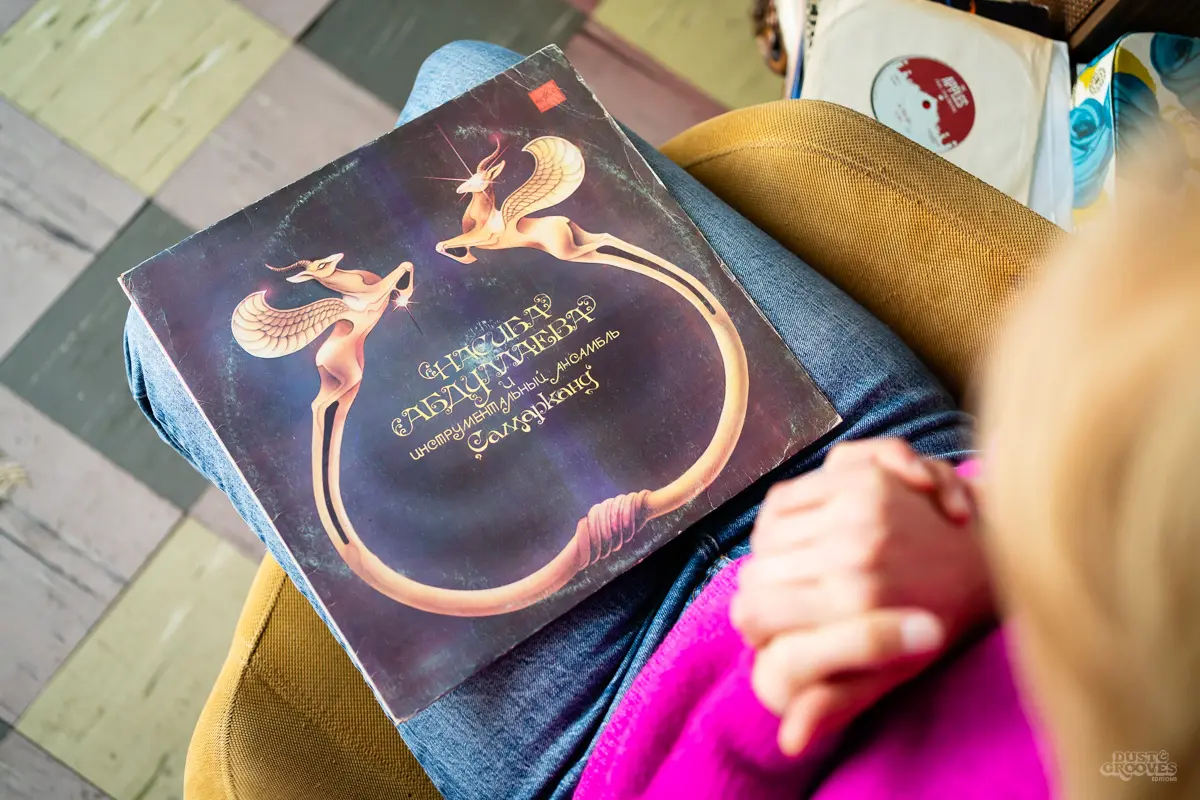
Nasiba Abdullayeva & the Samarkand Instrumental Ensemble – Self-titled. “Uzbekistan’s capital, Samarkand, is a melting pot of cultures and languages. Nasiba Abdullayeva, an Uzbek female singer of Jewish origin, started her career under the Soviet regime in the ’80s. State control over culture, society, and music suppressed freedom of expression and individualism, but favored folk music and invested in traditional music ensembles. A fusion of tradition, modern interpretations of maqams, synthesizers, and Nasiba’s hypnotic vocals make this album a pure treasure. It would not be in my collection if not for Tayfun from Deform Record Store, who generously shared one of the album copies with me.”
Can you talk more about digging—do you enjoy the hunt more than actually getting the album?
If I dig, it means I usually come back with records. But digging is an experience, like diving into a new reality. You have to have your eyes and ears open and leave your prejudices behind. To be a digger, you have to be extremely open to music and to people. You can’t just have a precise wish list; a wish list is very good for Discogs. But if you go digging, you’re coming back with a record that you never heard of. You’re letting yourself be surprised, you come back with a new definition of something. So you find records that are, for example, not very expensive but appear to be treasured. You find albums by extremely popular singers or bands, but that nobody knows of. It’s a very nourishing experience, these are the seeds to dig more into the stories, build up the history, explore more, develop something, and then bring it to somebody else.
Like the physical digging leads you to do an intellectual digging, in a way.
Yeah, and it’s also connected with traveling, being immersed in a new reality. This is something that was really missing in the last two years. It feels like forever! For one year, I haven’t bought one record because I live on an island and everything was closed, even the post wouldn’t come at some point. I usually don’t order, but I felt that this was the time for me to start ordering online. But when I started to order, the records didn’t arrive because I was really separated from everything. So, for one year I couldn’t buy any records. It was really hard for me.
I remember one experience, at the beginning of the pandemic. I live in a part of Istanbul where there is just a ferry between the city and me, and we were closed. Nobody could come to the island and nobody could leave. A friend of mine, Tayfun from my favorite record store in Istanbul, called me and I said “I really need a record, I want to listen to something new, I’m begging you”. He answered, “Listen, I will be taking a ferry from the city which will pass by your island, but I can’t step out of it because I don’t have a residency permit”. I said that I would come to the Ferry station. And the ferry stopped, he was there and he gave me the record—he was on the ferry and I was on the land! He said, “I miss you Kornelia”, I said, “I miss you so much and I’m so happy that you gave me this record”. It was the first record I bought for a couple of months. I remember walking along the coast and crying. This record symbolized the life that I used to have before. We couldn’t even shake hands, he just handed me the record. Then I realized, wow, records are extremely important to me.
It’s a beautiful story.
It was! And the sun was so amazing, everything was like… If I ever make a movie, this would be one of the scenes. Everything was perfect. Everything was so dramatic. He was masked, I was masked, we were wearing gloves! I think I even wore sunglasses so the virus wouldn’t come through my eyes. And we weren’t touching each other, we were connecting through a record. I waved to him, and I walked along the coast for twenty minutes, crying like a baby, in the golden sunset.
Who would you like to see featured next in Dust & Grooves?
I would like to see my Polish friends featured, the digging collective Soul Service. They dig in Polish funk and Polish music from the ‘70s and ‘80s. They are collectors and wonderful DJs who also release music and make compilations. They’re great people and really understand something special about the music they’re digging into.
- This interview took place in 2022. Kornelia is now back in Istanbul.
Kornelia Binicewicz is a record collector, curator, and cultural anthropologist living in Istanbul. She is the founder of Ladies on Records, a project that highlights female singers from Turkey and the Middle East from the ’60s to the ’80s. Through her DJing, compilations, and archival research, Kornelia uncovers overlooked music and tells the stories of women in male-dominated music scenes.
Website
IG
Further Adventures in Record Collecting
Dust & Grooves Vol. 2
Kornelia and 150 other great collectors are featured in the book Dust & Grooves Vol 2: Further Adventures in Record Collecting.
Become a member or make a donation
Support Dust & Grooves
Dear Dust & Groovers,
For over a decade, we’ve been dedicated to bringing you the stories, collections, and passion of vinyl record collectors from around the world. We’ve built a community that celebrates the art of record collecting and the love of music. We rely on the support of our readers and fellow music lovers like YOU!
If you enjoy our content and believe in our mission, please consider becoming a paid member or make a one time donation. Your support helps us continue to share these stories and preserve the culture we all cherish.
Thank you for being part of this incredible journey.
Groove on,
Eilon Paz and the Dust & Grooves team


